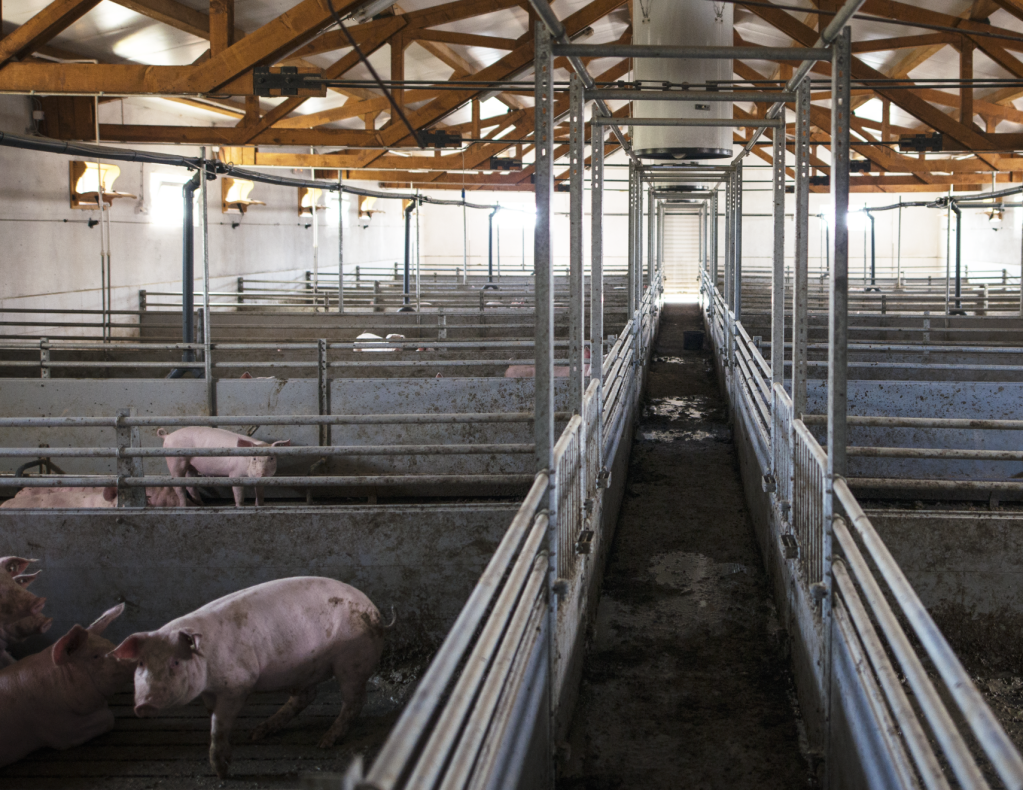
Ileitis
Disease
Ileitis is a common and costly gastrointestinal disease1. Also known as porcine proliferative enteropathy (PE), it is caused by Lawsonia intracellularis, a bacterium that infects the intestinal tract. It causes the wall of the ileum and colon to become thickened, resulting in diarrhoea, internal bleeding, reduced feeding efficiency and impaired growth.

Economic impact
In Europe, a cost associated with PE of up to 5 per pig has been estimated. Such economic losses are mainly due to the negative impact of PE on average daily gain (ADG), feed conversion rate (FCR), and sometimes mortality and culling rates. Reduced ADG and increased FCR generate variation of pig weights, which usually increase the time to market or cause the slaughter of pigs at less-than-optimal weights, resulting both in a loss of revenue and profit.
The major source of economic losses associated with ileitis arise from productivity drops caused by the disease2.
Increase in growth differences → uneven batches → greater costs
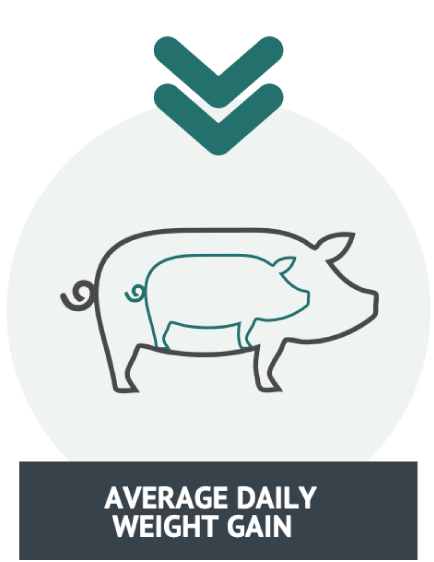
Can decrease
by up to 38%
Increase in the
time to reach
slaughter
weight.
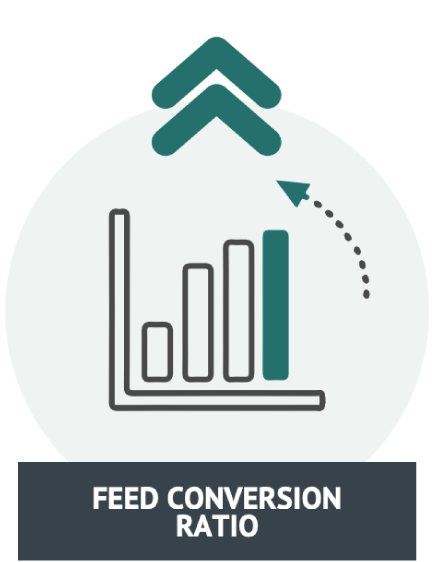
Can increase
by up to 27%
Lower increase in
weight with the
same consumption
of feed.
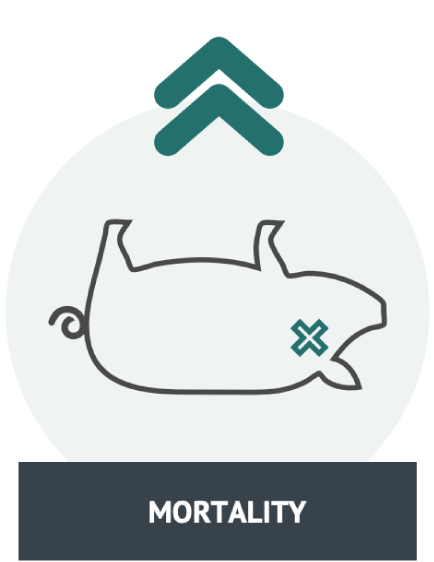
Can increase
by up to 24%3
In the acute stage
of the disease (pigs
by the end of the
fattening stage).
Based on results from case-control and experimental studies, the value of productivity losses caused by PE in the finishing phase ranges from US$5.98 to US$17.34 per pig marketed.2
Subclinical ileitis can have up to 20.8% impact on ADG and 20.4% impact on Feed Efficiency over 6 weeks.3

Prevalence
Ileitis can be present in acute, chronic and subclinical forms. Almost 100% of the world’s pig populations have some level of Lawsonia intracellularis infection.
Prevalence of ileitis4
Between 80-100% of European farms are infected with Lawsonia intracellularis
Herd
prevalences
(qPCR)
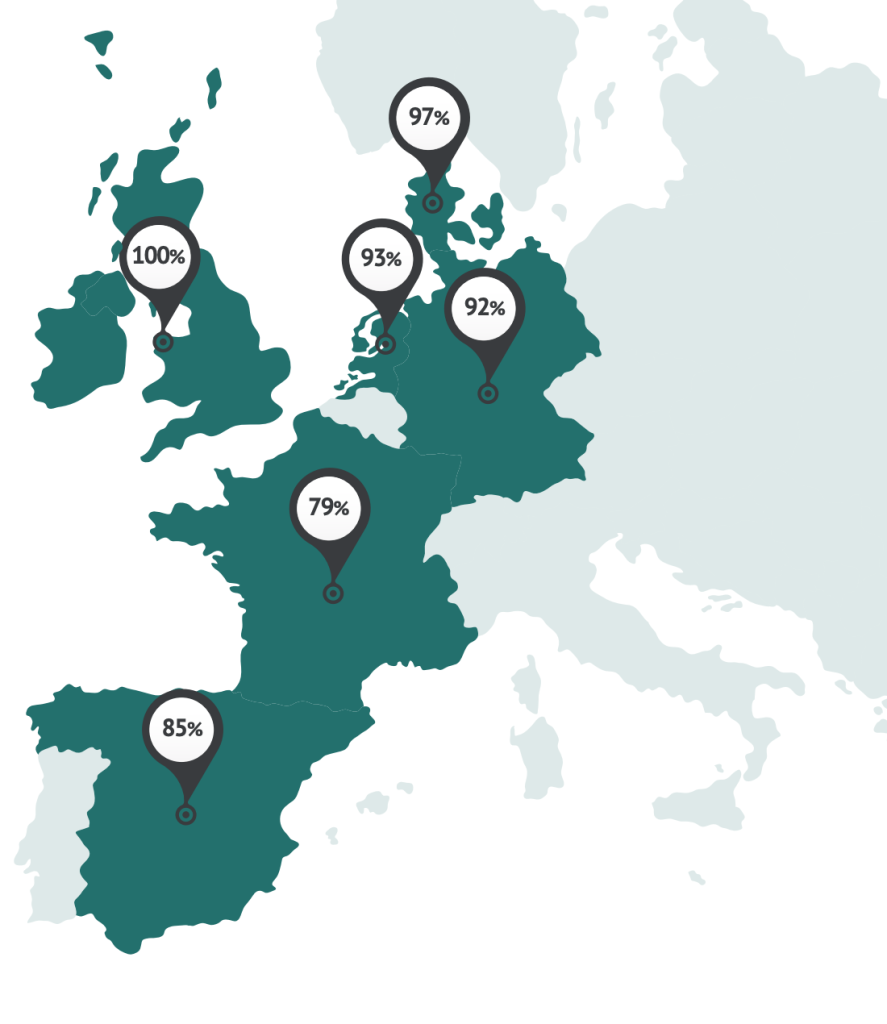

Diagnosis
Clinical signs of Ileitis can include:
- Pale / weak / thin pigs
- Diarrhoea / bloody scour
- Poor or irregular weight gain
Post-mortem examination can provide inconclusive proof of infection. For example:
- Intestinal wall thickening
- The presence of blood clots in intestinal lumen
Although gross intestinal lesions provide relevant information, diagnosing PE involves considering four important factors:
- Performance records
- Clinical signs
- Gross evaluation of intestinal lesions
- Laboratory testing

Treatment and prevention
The three key aspects for PE prevention:
Rodent control, as rodents (mice and rats) can get infected and be carriers of L. intracellularis.
Cleaning and Desinfection, as pigs get mainly infected through the contact with faeces.
Biosecurity, as L. intracellularis persists longer periods in the environment and contaminated tools.
Antimicrobial medication and improved management and biosecurity usually help prevent outbreaks.
Vaccination is an effective way control Ileitis. It can reduce bacterial shedding and help reduce the spread of bacteria. It also reduces lesions and improve weight gain.
1 Arnold M. et al. Prevalence of Lawsonia intracellularis in pig herds in different European countries. Porcine Health Management, 2019.
2 Holtkamp D, Economic losses associated with ileitis, 2019.
3 Fourchon A, Chouet S. Technical results of swine herds and serological results on pigs for Lawsonia intracellularis. Proceedings IPVS 2000.
4 Armbruster, AASV, 2013
Download the disease infographic
MSD Animal Health solutions to control ileitis (Lawsonia intracellularis)

IntestiPig: Porcilis® Lawsonia
Visit https://www.lawsonia.net/ for more information.
Porcilis Lawsonia is an inactivated lyophilized injectable vaccine that protects against ileitis for 21 weeks. It reduces diarrhea, loss of daily weight gain, intestinal lesions, bacterial shedding and mortality caused by Lawsonia intracellularis infection.
SOLUTIONS
Porcilis® Lawsonia
Inactivated vaccine against
Lawsonia intracellularis.


Onset of immunity: 4 weeks after vaccination
Duration of immunity: 21 weeks after vaccination.
Reconstitute with the Solvent for Porcilis Lawsonia or Porcilis® PCV M Hyo. Alone or mixed with Porcilis PCV M Hyo, it can be concurrently used with Porcilis PRRS.
BENEFITS
- Reduces diarrhoea occurrence and intestinal lesions.
- Reduces faecal shedding of L. intracellularis.
- Reduces mortality.
HOW TO USE IT
- Single 2ml dose at three weeks or older.
- 1 single step: reconstitute with the diluvant Emunade or with Porcilis PCV M hyo
- No interference with in-farm treatments.
Available in EU, and under registration in APSA

IntestiPig: Porcilis® Ileitis
Visit https://www.ileitis.net/ for more information.
Porcilis Ileitis is the first ready to use injectable vaccine that offers at least 20-weeks of immunity to control ileitis caused by Lawsonia intracellularis.
SOLUTIONS
Porcilis® Ileitis
Ready-to-use vaccine against
Lawsonia intracellularis.


Duration of immunity: at least 20 weeks
BENEFITS
- Easy to use.
- Long-lasting immunity.
- Reduced colonization and shedding.
HOW TO USE IT
- Single 2ml dose at three weeks or older.
Available in NA, APSA, and LATAM.

The IDAL Way: Porcilis® Lawsonia ID
IDAL is a needle-free intradermal device, developed to give a fixed 0.2 ML vaccine dose in the dermis of the pig.
A range of vaccines, among which Porcilis® Lawsonia ID, have been developed specifically for the use with IDAL or equivalent device*
* a multi-dose needle-free injection device for intradermal application of liquids suitable to deliver a “jet-stream” volume of vaccine (0.2ml ± 10%) through the epidermal layers of the skin.
Porcilis® Lawsonia ID is an intradermal vaccine that protects against ileitis in a single administration with IDAL device.
SOLUTIONS
Porcilis® Lawsonia ID
Ready to use in a single step vaccine
against Lawsonia intracellularis.


Onset of immunity: 4 weeks after vaccination.
Duration of immunity: 21 weeks after vaccination.
How to mix: reconstitute with the Solvent for Porcilis Lawsonia ID or with Porcilis PCV ID.
BENEFITS
- Improved welfare and less stress for the pigs and employees alike.
- Immune response comparable to traditional intramuscular vaccination.
- No risk of muscle tissue damage as the vaccine is deposited in the skin.
- Reduced risk of abscess formation and meat discard.
- Increased flexibility in the choice of vaccination area.
HOW TO USE IT
- Single 0.2ml dose (reconstituted vaccine) from 3 weeks of age.
- 1 single step: reconstitute with the solvent X-SOLVE 12 or with Porcilis PCV ID.
- Intradermal administration with IDAL device.
- No interference with feed, water chlorination, antibiotics, etc.
*Available in EU and under registration in LATAM and APSA



